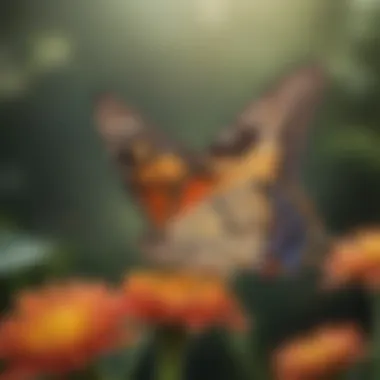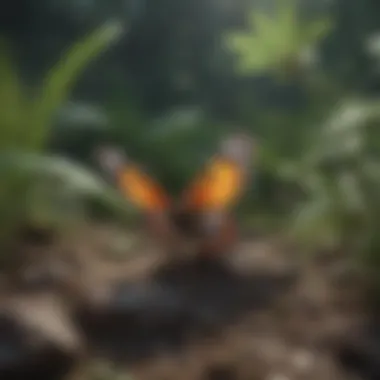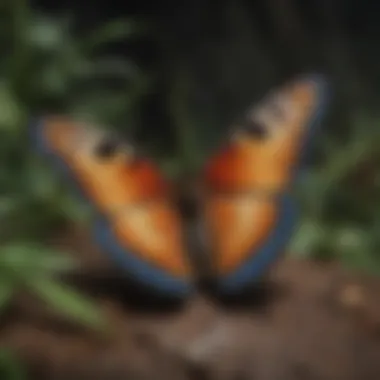Exploring the Global Diversity of Butterflies


Intro
Butterflies are among the most captivating insects on the planet. Their vibrant colors, intricate patterns, and delicate movements have mesmerized observers for centuries. As vital components of various ecosystems, butterflies perform essential functions such as pollination and serve as indicators of ecological health. Despite their beauty, these insects face numerous threats, including habitat loss, climate change, and pesticide use. This article aims to highlight the global diversity of butterflies, discussing their distribution, ecological significance, and the multifaceted roles they play within different ecosystems.
Animal Overview
Common Names
Butterflies belong to the order Lepidoptera, which encompasses a wide range of species. Common names vary regionally, often reflecting local culture or specific characteristics. Some well-known names include the Monarch Butterfly, Swallowtail, and Painted Lady. These names often evoke associations with their physical appearance or behavior.
Scientific Classification
Butterflies are classified into several families within the Lepidoptera order. Notable families include:
- Nymphalidae (brush-footed butterflies)
- Pieridae (whites and sulfurs)
- Papilionidae (swallowtails)
- Lycaenidae (gossamer-winged butterflies)
Each family is further divided into genera and species, accounting for the almost 180,000 species identified to date.
Geographic Range
Butterflies are found on every continent except Antarctica. Their distribution reflects diverse climatic and ecological conditions. Tropical regions, such as the Amazon Rainforest and Southeast Asia, demonstrate the highest species diversity. In contrast, temperate zones host fewer species but include iconic ones like the Monarch, which migrates vast distances between breeding and wintering grounds. Their geographic range is crucial for understanding their ecological roles and conservation needs.
Behavior and Social Structure
Social Behavior
Butterflies exhibit a range of social behaviors, though many species are solitary. Some, like the Monarch, gather in large groups during migration. This behavior not only facilitates navigation across long distances but also serves as a strategy to avoid predation.
Communication
Communication among butterflies primarily occurs through visual signals. Males often engage in vibrant displays to attract females. Additionally, pheromones are used for chemical communication during mating rituals, signaling reproductive readiness and territory dominance.
Mating and Reproduction
Mating usually occurs in warm months when conditions are favorable. Female butterflies lay eggs on host plants, selected based on the larvae's dietary needs. This relationship between butterflies and plants is crucial for the survival of their offspring, directly linking their reproductive success to the availability of suitable habitats.
Habitat and Ecosystem
Natural Habitat
Butterflies inhabit various ecosystems, including forests, grasslands, wetlands, and urban areas. Each habitat presents unique challenges and resources that influence butterfly populations. For example, forested habitats offer shelter from predators and ample food sources.
Food Sources and Diet
Adult butterflies primarily feed on nectar from flowers. This diet not only sustains them but also aids in pollination, a crucial ecological service. Different species prefer specific flowers, creating a intricate balance within the ecosystem.
Role in Ecosystem
Butterflies play a vital role in maintaining ecological balance. They contribute to pollination, helping plants reproduce. This, in turn, supports diverse animal life. Moreover, butterflies serve as prey for birds, bats, and other wildlife, indicating the health of their environments. Their decline can signal broader ecological issues, making them critical indicators for researchers and conservationists.
Understanding butterfly diversity is essential for preserving these delicate creatures and the ecosystems they support.
Intro to Global Butterfly Diversity
Butterflies are not just visually appealing creatures; they offer critical insights into the health of our ecosystems. Understanding global butterfly diversity is essential for multiple reasons. It reveals the complex interconnections between butterflies and the environments they inhabit. Additionally, it highlights the unique adaptations and behaviors that have enabled butterflies to thrive in various ecological niches across the planet. This article seeks to shine a light on these fascinating insects, emphasizing their ecological significance and cultural relevance.
Defining Butterflies and Their Taxonomy
Butterflies belong to the order Lepidoptera, which also includes moths. Within this order, butterflies are divided into two primary families: Papilionidae, commonly known as swallowtails, and Nymphalidae, known as brush-footed butterflies. Each family includes numerous species, all exhibiting distinct physical characteristics and behaviors.


Butterflies are characterized by their colorful wings and unique life cycle, which includes four stages: egg, larva (caterpillar), pupa (chrysalis), and adult. This metamorphosis is a key factor in their adaptability and survival. Taxonomy plays a crucial role in understanding butterfly diversity as it helps categorize species based on their evolutionary relationships. Through classification, scientists can better study their distribution patterns and ecological roles.
Global Distribution Overview
The distribution of butterflies is vast and diverse. They can be found on every continent except Antarctica. Most species reside in tropical and subtropical regions, where warm climates and abundant vegetation facilitate their life cycles. For example, the Amazon rainforest is home to an extensive variety of butterfly species, showcasing a rich tapestry of colors and forms.
In temperate regions, such as North America and Europe, butterfly populations are also significant, although fewer in species diversity compared to tropical areas. Seasonal migrations, like that of the Monarch butterfly, illustrate how global climate factors influence distribution patterns. Understanding these distribution dynamics is vital for conservationists aiming to protect habitats essential for butterfly survival.
“Butterflies may be delicate, but their roles in our ecosystems are robust and profound.”
The exploration of butterfly diversity is not merely an academic exercise; it has practical implications for biodiversity conservation and ecosystem health. By studying their distributions and taxonomies, we can develop strategies to mitigate threats facing these beautiful insects and ensure their populations thrive for generations to come.
The Ecological Role of Butterflies
Butterflies play a significant role in maintaining the health and balance of different ecosystems. Their presence in varied habitats is an indicator of ecological stability, and they contribute to ecosystem functioning through essential services. Understanding the ecological role of butterflies can greatly inform conservation efforts and highlight the interconnection of species within their environments.
Pollination and Ecosystem Health
Butterflies are not just pretty to look at; they are vital pollinators. When butterflies visit flowers to feed on nectar, they frequently transfer pollen from one bloom to another, facilitating sexual reproduction in plants. This process enhances plant diversity and contributes to the stability of ecosystems.
Many crops rely on butterfly pollination. Fruits such as berries, melons, and orchards benefit from the activities of these insects. Consequently, healthy butterfly populations contribute to agricultural productivity.
Key Benefits of Butterfly Pollination:
- Promotes genetic diversity among plant species
- Supports food production for humans and wildlife
- Ensures the growth of native plants that sustain local ecosystems
In addition to pollination, butterflies serve as prey for various animals, creating a fundamental link in the food web. The decline in butterfly populations can lead to cascading effects on both flora and fauna, ultimately destabilizing ecosystems.
Butterflies as Indicators of Environment
Butterflies are often referred to as
Biodiversity and Adaptation
Biodiversity refers to the variety of life forms within a given habitat or ecosystem. It helps maintain ecosystem health, promotes resilience, and supports the adaptation of species. In relation to butterflies, their vast species diversity illustrates not only their evolutionary success but also their nuanced relationships with different environments. The interdependence among species often leads to a richer understanding of ecological balances. Loss of biodiversity can disrupt these systems, which can have a cascade effect on various organisms, including humans.
Butterflies are a vibrant example of biodiversity. They occupy various habitats across different regions, showcasing a range of colors, sizes, and behaviors. Each species has adapted to its specific environment, utilizing unique strategies to thrive. This adaptation is critical as it allows butterflies to occupy niches in environments, from tropical rainforests to arid deserts.
Different Species and Their Habitats
Butterflies exist in a plethora of species, each suited to distinct habitats. For instance, the Monarch butterfly is widely known for its remarkable migration journey between North America and central Mexico. This species relies on milkweed plants for its lifecycle, showcasing a deep connection to the environment. Different climates provide suitable options for other species, such as the Swallowtail, which thrives in warmer areas and can often be seen at gardens, parks, and meadows.
- Tropical Butterflies: Brightly colored and diverse, they often reside in rainforests.
- Temperate Butterflies: These species adapt to cooler climates and can be often found in meadows and along hedgerows.
- Mountain Butterflies: Often limited by altitude, these butterflies have features adapted to cooler temperatures and thinner air.
Ililience of butterfly species represents the health of their ecosystems, making them crucial indicators. Where butterflies thrive, ecosystems tend to be balanced and functioning well.
Adaptation Mechanisms in Butterflies
Adaptation mechanisms enable butterflies to evolve according to their environments. These mechanisms can include physiological, behavioral, and morphological adaptations. For instance:
- Camouflaging Coloration: Many species possess wing patterns that mimic their surroundings. This serves as a defense mechanism against predators.
- Seasonal Changes: Some butterflies exhibit variations in color or size during different times of the year, adapting to climate changes.
- Behavioral Adaptations: Butterflies change their feeding habits depending on nectar availability during specific seasons.
Migration Patterns of Butterflies
Migration patterns play a significant role in the life cycles of butterflies. Understanding these patterns is essential in the study of their ecological behavior and the challenges they face. Butterflies migrate for various reasons, including seeking suitable climates, finding food sources, and breeding. Additionally, examining these patterns provides key insights into conservation efforts. By recognizing migratory routes, we can pinpoint areas needing protection and establish crucial conservation strategies.
The Monarch Butterfly Migration
The Monarch butterfly is perhaps the most famous migratory butterfly. Every year, millions of Monarchs travel thousands of miles from North America to central Mexico. This migration can span more than 3,000 miles. The butterflies leave their breeding grounds in late summer and arrive in their winter habitats by October. This journey is not straightforward; it includes navigating through various terrains and changing weather conditions.


Before making this lengthy trek, Monarchs go through several stages. They rely on environmental cues, such as temperature and daylight, to determine when to start their migration. Preparing for the journey involves accumulating fat reserves for energy. These reserves are crucial for surviving the long trips and sustaining them during the winters in their destinations.
Monarch butterflies are unique, as no single butterfly makes the entire round trip. Each generation contributes to the journey, with a few making it back to the breeding grounds in the spring months.
Over the years, the Monarch's migration has drawn attention and increased interest in conservation. Deforestation and climate change threaten their migratory routes and habitats. Various organizations work to protect these vital areas, ensure safe passage, and educate the public about the Monarch's remarkable journey. These initiatives are essential for preserving not just the Monarch, but also the ecological balance of the habitats they navigate.
Other Notable Migration Patterns
While the Monarch butterfly is the most well-known, other butterfly species also exhibit notable migration behaviors. The Swallowtail butterfly, for instance, has regional migrations based on local conditions. In some places, they may travel short distances to follow blooming flowers or suitable environmental conditions.
Some other species do not migrate as extensively but show local movements. The Painted Lady butterfly has been observed moving across large distances to exploit seasonal food sources. Its migrations can be unpredictable, and some populations can travel ovber thousands of miles in search of favorable climates.
Moreover, the migration patterns of butterflies demonstrate their adaptability. Environmental changes, such as urbanization or agriculture, can impact these patterns. Research suggests that some species may adjust their migratory routes in response to habitat alterations. Thus, monitoring these migration patterns can help identify broader environmental changes affecting butterfly populations.
In summary, migration is an integral aspect of butterfly life cycles. Understanding these patterns allows for better conservation strategies and awareness of ecological shifts. As we consider the future of these species, recognizing their migratory behavior is essential in protecting both butterflies and the environments they inhabit.
Threats to Butterfly Populations
The declining numbers of butterfly populations are a pressing issue that merits stern focus. Butterflies are not just visually engaging; they play crucial roles within ecosystems. Their decline can signal broader environmental issues. Understanding the threats they face will aid in the efforts to conserve these essential species, benefitting the overall health of ecosystems.
Habitat Loss and Fragmentation
The loss and fragmentation of natural habitats are primary threats to butterfly populations. Urbanization, agriculture, and deforestation contribute significantly to this issue. When habitats are destroyed or divided, butterflies lose not only spaces for feeding and breeding but also the intricate networks they rely on.
- Urban development often leads to the destruction of grasslands, forests, and wetlands, which serve as vital habitats for various butterfly species.
- Agricultural practices, especially monocropping, reduce biodiversity, making it difficult for butterflies to find necessary resources like host plants.
- Fragmented habitats can isolate populations, leading to inbreeding and reduced genetic diversity, which can ultimately threaten their survival.
Climate Change Impact
Climate change is reshaping ecosystems, altering migration patterns and habitat suitability for many butterfly species. Changes in temperature and weather patterns can disrupt the delicate synchrony between butterflies and their food sources.
- Many butterflies depend on specific weather conditions to thrive. Warmer temperatures can cause mismatches between butterflies emerging in spring and the blooming of plants they feed on.
- Extreme weather events, such as droughts or heavy rains, can directly impact butterfly populations by destroying habitats and reducing food availability.
- Climate change can shift the range of many butterfly species toward cooler areas, which may not always be available or suitable.
Pesticides and Pollution
The use of pesticides and pollution presents grave risks to butterfly populations. These harmful substances can devastate not only the targeted pests but also the beneficial insects, including butterflies.
- Pesticides can kill butterflies directly or through larval stages when they feed on contaminated host plants.
- Pollution can alter the quality of habitats that support butterfly life cycles. For example, water pollution can affect the aquatic plants butterflies depend on for breeding.
- The accumulation of harmful chemicals in the environment can lead to a decline in population health and viability.
The survival of butterflies is not just about conserving a singular species; it is a reflection of the overall health of our ecosystems. It is essential to address these threats with urgency.
The threats to butterfly populations reinforce the fragility of life within ecosystems. With habitat loss, climate change, and pollution undermining these insects, immediate actions are necessary to mitigate risks to butterfly diversity and, by extension, ecosystem health.
Conservation Efforts for Butterflies
Conservation efforts for butterflies are crucial as they face numerous threats that endanger their populations. Protecting these insects goes beyond mere aesthetics; it is vital for maintaining biodiversity and ecological stability. Butterflies serve significant roles in pollination and act as indicators of ecosystem health. Understanding conservation strategies enables us to preserve their habitats and enhance both their survival and that of other species.
Global Initiatives and Programs
Many global initiatives aim to protect butterfly populations. Organizations such as the Butterfly Conservation Society and the International Union for Conservation of Nature develop programs focusing on habitat restoration, pollution reduction, and climate action.
- Habitat Restoration: Projects often involve reforesting areas where butterfly species used to thrive. Native plants are encouraged to grow, creating environments rich in resources for butterflies.
- Public Awareness Campaigns: Many organizations implement campaigns to educate the public about the importance of butterflies and their habitats. Such initiatives often lead to direct community participation in conservation efforts.
- Legislation Support: Support for policies that protect butterfly habitats is essential. Laws aimed at reducing pesticide use and promoting sustainable agricultural practices contribute significantly to conservation goals.
The survival of butterfly populations is indispensable for ecological balance and biodiversity.
Community-Based Conservation Strategies
Community-based strategies focus on engaging local populations in butterfly conservation. These approaches recognize that local knowledge and active participation are key to successful outcomes.
- Education Programs: Schools and local organizations offer programs to teach children and adults about the life cycle of butterflies and their environmental role. Understanding these connections fosters a sense of responsibility towards local wildlife.
- Butterfly Corridors: Communities create corridors connecting fragmented habitats. These pathways allow butterflies to migrate and thrive, encouraging genetic diversity within populations.
- Citizen Science Projects: Involving community members in butterfly monitoring helps gather valuable data. Volunteers may participate in counting butterfly species, which contributes to scientific research and awareness.


Cultural Significance of Butterflies
The cultural significance of butterflies extends beyond their aesthetics. These insects hold symbolic meaning and influence across different cultures. Throughout history, butterflies have represented transformation, beauty, and even the souls of the departed. Their life cycle from caterpillar to chrysalis and finally to vibrant butterfly mirrors themes of change and rebirth. This aspect is pivotal in understanding how societies perceive both nature and life.
Symbolism in Various Cultures
In various cultures around the globe, butterflies are often linked to important beliefs and traditions. For instance, in Chinese culture, butterflies symbolize love and marital happiness. They are often seen in art and decor, celebrating romantic relationships. Likewise, in Native American folklore, butterflies are regarded as messengers of change and are associated with joy and color. These associations reveal how deeply embedded butterflies are in the fabric of human culture.
- China: Butterflies symbolize love and harmony.
- Native American tribes: Seen as symbols of change.
- Japan: The butterfly represents the spirit or soul.
- Greek mythology: The transformation from caterpillar to butterfly is often linked to Psyche, the personification of the soul.
Such symbolic representations influence numerous cultural practices, festivals, and artworks, showing the profound impact butterflies have in shaping human experiences and beliefs.
Butterflies in Art and Literature
The presence of butterflies in art and literature is pervasive. Many poets and writers have used butterflies as metaphors for a variety of themes, such as freedom, fragility, and beauty. In literature, the butterfly often represents the fleeting nature of life. A notable example is in the poem “The Butterfly” by James Wright, which explores themes of connection and transformation. The imagery of butterflies contributes to a deeper appreciation of life’s ephemeral nature.
Additionally, artists have long used their forms and colors to invoke emotions and provoke thought. From paintings to sculptures, the delicate structure of butterflies is often a focal point. Legendary artists like Vincent van Gogh and Gustav Klimt have incorporated butterfly motifs into their masterpieces. Their work not only captures beauty but also hints at deeper meanings that resonate with audiences.
Butterflies remind us of the transient nature of life, turning ordinary moments into extraordinary ones.
Butterflies in Urban Environments
Urban environments are often perceived as the antithesis of nature. However, they can play a vital role in supporting butterfly populations. Urban landscapes, when managed strategically, foster biodiversity. Butterflies are not only beautiful but also serve essential ecological functions. Hence, integrating them into urban planning is increasingly important.
The presence of butterflies in cities can enhance the quality of urban ecosystems and promote environmental awareness among residents.
Creating Butterfly Gardens
Butterfly gardens are specialized spaces designed to attract these insects. By planting native flowering plants, we can create habitats that provide food and shelter. Here are some crucial considerations:
- Select Native Species: Choosing local plants ensures that butterflies find the nectar they need. Species such as milkweed, coneflower, and aster are effective in attracting various butterfly species.
- Offer Host Plants: Apart from nectar sources, host plants are essential for the lifecycle of butterflies. For example, caterpillars of the Monarch butterfly thrive on milkweed.
- Provide Sunlight and Water: Butterflies favor sunny locations where they can bask. Water sources like shallow dishes or small ponds can also benefit them.
Implementing butterfly gardens can stimulate interest and educational opportunities for communities. Schools or community groups often lead these efforts.
Urban Wildlife Corridors
Urban wildlife corridors are pathways connecting green spaces. These corridors facilitate the movement of butterflies and other creatures between habitats. Their significance is highlighted through several key aspects:
- Enhancing Connectivity: Corridors allow species to access critical resources, leading to healthier populations. This is crucial in densely populated areas where habitat fragmentation can occur.
- Promoting Biodiversity: By providing a means to navigate the urban landscape, corridors boost the number of species that can thrive in cities.
- Supporting Ecosystem Services: Corridors preserve pollination services which directly benefit urban agriculture and gardens. This relationship enhances food production and improves urban living conditions.
Ultimately, both butterfly gardens and urban wildlife corridors transform cities. They create a more inviting atmosphere for butterflies and foster a sense of connection to nature for urban residents.
Future of Butterfly Populations
The future of butterfly populations is a vital topic due to the intricate relationship between these insects and the broader ecosystem. Butterflies are not only stunning creatures but also serve as important indicators of environmental health. Their decline can signal problems within ecosystems, often leading to consequences for various species, including humans. Understanding what lies ahead for these populations can inform conservation practices and raise awareness about environmental issues.
Understanding Expected Trends
Recent studies indicate that butterfly populations are experiencing significant changes. Climate change is altering their habitats. For instance, warmer temperatures can expand the range of certain species, while others struggle to adapt. Additionally, urban expansion and agriculture continue to encroach on natural habitats, leading to fragmentation.
Some observed trends include:
- Declining Species: Certain species, like the Monarch butterfly, have seen substantial population declines due to habitat loss and changing climate.
- Emerging Species: As climates shift, some new species may appear in areas where they were once absent.
- Behavioral Changes: Altered weather patterns can influence migration and breeding cycles, impacting the biodiversity of various regions.
Conservationists need to monitor these trends closely. Data on population shifts and behavior can help in tailoring intervention strategies.
Importance of Public Engagement
Engaging the public is critical for the survival and thriving of butterfly populations. Education plays a vital role. Increasing awareness about the plight of butterflies can drive community involvement in conservation efforts. People often relate to butterflies due to their beauty and their symbolism in various cultures. This connection can foster a sense of responsibility towards protecting them.
Key aspects of public engagement include:
- Education Programs: Schools and communities can create educational programs to inform people about butterflies' ecological roles and threats they face.
- Citizen Science Initiatives: Involving the public in data collection can enhance understanding of butterfly populations while raising awareness. Projects like the North American Butterfly Association's count allow enthusiasts to contribute to vital research.
- Support for Conservation Organizations: Encouraging community support for organizations focused on butterfly conservation can lead to more robust efforts in preserving habitats and mitigating threats.
Public involvement is crucial. Engaging communities in butterfly conservation efforts promotes action towards restoring their populations.
By fostering a widespread understanding and passion for butterflies, society can help ensure their future, benefiting entire ecosystems in the process.







